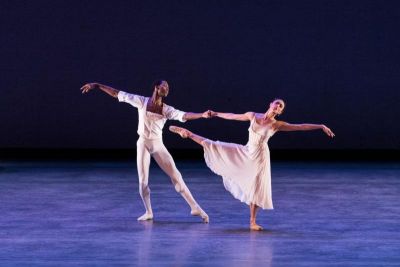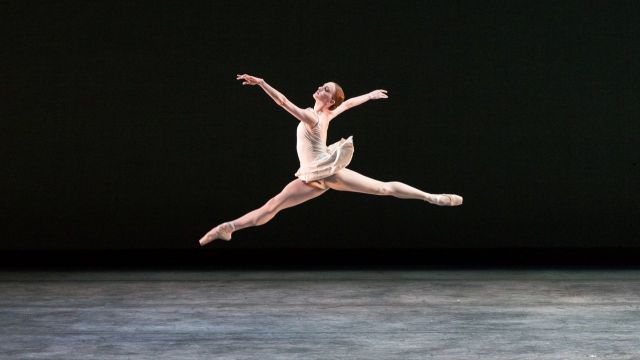THREE MASTERPIECES
The second program by American Ballet Theatre in their exclusive Brisbane season proved to be just as stimulating and rewarding as their first. Three Masterpieces was a mixed bill of one-act ballets that showcased the brilliant talents of the company.
 Contemporary dance icon Twyla Tharp created Bach Patita for the ABT in 1983, which after a twenty-eight year absence was painstakingly restored from two grainy videos to the repertoire last year by ballet mistress Susan Jones. A neoclassical work for three pairs of principals, seven pairs of soloists and a female corps of 16, performed to Bach’s Partita No. 2 in D Minor for Solo Violin, it was bold, full of innovation, and one which allowed for the individuality of the performers to shine through. Misty Copeland and James Whiteside brought a lyrical flair to the first duet, Gillian Murphy and Marcello Gomes were flirty in the second, whilst Stella Abrera and Calvin Royal lll, delivered style with a flourish in the third. The technical execution of all three couples in their pas-de-deux work thrilled, whilst the female corps, striking in designer Santo Loquasto’s knee-length brown dresses, added an unmistakable vivace whenever they appeared. Charles Yang’s slightly-amplified solo violin accompaniment from the pit was exemplary.
Contemporary dance icon Twyla Tharp created Bach Patita for the ABT in 1983, which after a twenty-eight year absence was painstakingly restored from two grainy videos to the repertoire last year by ballet mistress Susan Jones. A neoclassical work for three pairs of principals, seven pairs of soloists and a female corps of 16, performed to Bach’s Partita No. 2 in D Minor for Solo Violin, it was bold, full of innovation, and one which allowed for the individuality of the performers to shine through. Misty Copeland and James Whiteside brought a lyrical flair to the first duet, Gillian Murphy and Marcello Gomes were flirty in the second, whilst Stella Abrera and Calvin Royal lll, delivered style with a flourish in the third. The technical execution of all three couples in their pas-de-deux work thrilled, whilst the female corps, striking in designer Santo Loquasto’s knee-length brown dresses, added an unmistakable vivace whenever they appeared. Charles Yang’s slightly-amplified solo violin accompaniment from the pit was exemplary.
 Tharp’s work although it was graceful, with clean lines, lacked emotion which was something Alex Ratmansky’s Seven Sonatas had. A gesture, touch or a held look gave the ballet an intimacy that was papable. Ratmansky, a former Artistic Director of the Bolshoi Ballet, his work, seen in Brisbane last year in The Bright Stream, has that remarkably robust Russian style, and Seven Sonatas was elevated because of it. Set to seven Keyboard Sonatas by Domenico Scarlatti, three couples dressed in white; Stella Abrera and Calvin Royal lll, Sarah Lane and Herman Cornejo, and Christine Shevchenko and Joseph Gorak, performed a series of solos, duets and group arrangements that were playful, nuanced and exuberant. Sterling accompaniment was provided by Barbara Bilach at an on-stage grand-piano.
Tharp’s work although it was graceful, with clean lines, lacked emotion which was something Alex Ratmansky’s Seven Sonatas had. A gesture, touch or a held look gave the ballet an intimacy that was papable. Ratmansky, a former Artistic Director of the Bolshoi Ballet, his work, seen in Brisbane last year in The Bright Stream, has that remarkably robust Russian style, and Seven Sonatas was elevated because of it. Set to seven Keyboard Sonatas by Domenico Scarlatti, three couples dressed in white; Stella Abrera and Calvin Royal lll, Sarah Lane and Herman Cornejo, and Christine Shevchenko and Joseph Gorak, performed a series of solos, duets and group arrangements that were playful, nuanced and exuberant. Sterling accompaniment was provided by Barbara Bilach at an on-stage grand-piano.
 The final ballet and crème-de-la-crème of the trio, Jerome Robbins’ classic Fancy Free, was a work that has been in the company’s repertoire since it was first created in 1944. Set in New York in the period in which it was written, the story of three sailors on shore leave during wartime and the girls they meet is simply irresistible. It is the quintessential American Ballet and this production of it is masterly in its staging by Jean-Pierre Frohlich. The ballet opens with a typical forties pop tune playing on the radio when the curtain goes up and we see Oliver Smith’s barroom set and as the bartender turns the radio down, from the orchestra pit a solo honky-tonk piano starts playing a blue-note theme. Three sailors enter and suddenly the full orchestra takes over and sweeps us up in an orgy of big-city New York sound that only Leonard Bernstein can capture.
The final ballet and crème-de-la-crème of the trio, Jerome Robbins’ classic Fancy Free, was a work that has been in the company’s repertoire since it was first created in 1944. Set in New York in the period in which it was written, the story of three sailors on shore leave during wartime and the girls they meet is simply irresistible. It is the quintessential American Ballet and this production of it is masterly in its staging by Jean-Pierre Frohlich. The ballet opens with a typical forties pop tune playing on the radio when the curtain goes up and we see Oliver Smith’s barroom set and as the bartender turns the radio down, from the orchestra pit a solo honky-tonk piano starts playing a blue-note theme. Three sailors enter and suddenly the full orchestra takes over and sweeps us up in an orgy of big-city New York sound that only Leonard Bernstein can capture.
 Cory Stearns, James Whiteside and Daniil Simkin were an appealing trio of sailors trying to pick-up dates, and Luciana Paris, Isabella Boylston and Leann Underwood, a pretty trio of girls looking to be wooed. Robbins’ ballet, which felt very Broadway and later was expanded into the musical On The Town, gave each of the guys a ‘show-off’ solo which embraced a galop, waltz and danzon. Simkin’s comic, cocky bravado wasparticularly appealing in this sequence. Kermit Love’s costumes for the girls added a vivid touch with Paris in yellow, Boylston in mauve, and Underwood in blue. Bernstein’s unfamiliar score, his first for the theatre, was dominated by the blue-note piano theme which kept on recurring throughout. There were times when you thought the music was going to break out into West Side Story so distinctive is Bernstein’s orchestral colouring. Under conductor Charles Barker’s baton, the Queensland Symphony Orchestra gave a dynamic reading of it.
Cory Stearns, James Whiteside and Daniil Simkin were an appealing trio of sailors trying to pick-up dates, and Luciana Paris, Isabella Boylston and Leann Underwood, a pretty trio of girls looking to be wooed. Robbins’ ballet, which felt very Broadway and later was expanded into the musical On The Town, gave each of the guys a ‘show-off’ solo which embraced a galop, waltz and danzon. Simkin’s comic, cocky bravado wasparticularly appealing in this sequence. Kermit Love’s costumes for the girls added a vivid touch with Paris in yellow, Boylston in mauve, and Underwood in blue. Bernstein’s unfamiliar score, his first for the theatre, was dominated by the blue-note piano theme which kept on recurring throughout. There were times when you thought the music was going to break out into West Side Story so distinctive is Bernstein’s orchestral colouring. Under conductor Charles Barker’s baton, the Queensland Symphony Orchestra gave a dynamic reading of it.
Peter Pinne
Images: Darren Thomas, Photo Co.
Subscribe to our E-Newsletter, buy our latest print edition or find a Performing Arts book at Book Nook.

